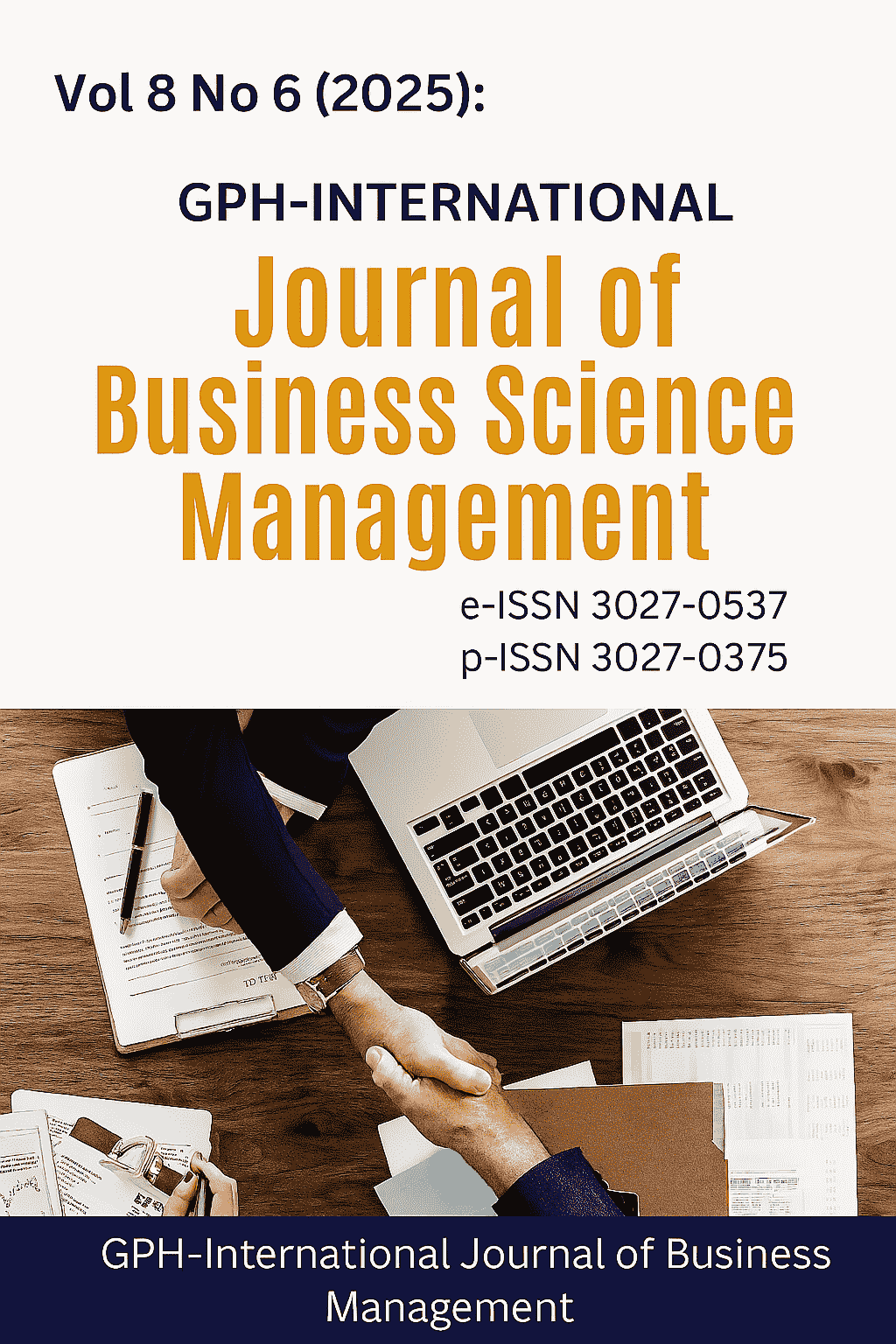BRAND ORIENTATION: A PANACEA FOR ELECTORATES’ INTENTION TO VOTE IN RIVERS STATE, NIGERIA
Abstract
The paper attempts to evaluate the connection amongst political brand orientation and intention to vote political parties in elections in Rivers State. The researcher employed the descriptive method which allowed for the identification and analysis of a pattern and described the behaviour of the given phenomenon without additional force. The population was all the voters in the twenty- three (23) Local Government Areas of Rivers State. The current population of registered voters in Rivers state is 3,215,273. A sample size of 400 respondents was drawn from the study population using the Taro Yamane formula. The study employed the Correlation analysis to test the hypothesis with the aid of SPSS. The results demonstrate that political brand orientation had a positive influence on voters’ intention to vote in Rivers State, Nigeria. It recommends that political parties in Rivers State should consciously work on their brand personality, brand awareness, brand association, brand orientation, perceived quality and brand trust holistically as these factors all work together to achieve success and progress in the political process in every democracy.
Downloads
References
Aaker, D. A. (1996). Brand equity, capitalising on the value of a brand name. The Free Press.
Adewale, A. A. & Bamidele, A. A. (2016). The relationship between brand trust and customer loyalty: The moderating impact of demographic characteristics. International Journal of Marketing Practices, 1(1), 1-23.
Ahmed, M.A., Lodhi, S.A. & Shahzad (2011). Political brand trusting a candidate in the age of mistrust. Jibus Retail Manage Res, 5, 131-141.
Alkhawaldeh, A. M, Al-Salaymeh, M., Alshare, F., & Eneizan, B. M. (2017). The effect of brand awareness on brand loyalty: Mediating role of brand commitment. European Journal of Business and Management, 9(36), 38-47.
Alkhawaldeh, A. M., Salleh, S. M. & Halim, F. B. (2016). Brand equity and brand loyalty: New perspective. International Review of Management and Marketing, 6(4), 722-730.
Ambler, T. (1992). Need-to-know Marketing. Century Business.
Ashraf, M. (2018). Impact of brand association on consumer buying behaviour in foot ware industry: The case of Punjab, Pakistan. International Journal of Academic Research in Business and Social Sciences, 8(3), 91-102.
Baumgarth, C. (2010). Living the brand: Brand orientation in the business-to-business sector. European Journal of Marketing, 44(5), 653-671.
Beck, P. A., Dalton, R. J., Greene, S. & Huckfeldt, R. (2002). The Social Calculus of Voting: Interpersonal, Media, and Organizational Influences on Presidential Choices. American Political Science Review, 96(1), 57- 73. https://doi.org/ 10.1017/S0003055402004239.
Bennett, P. D. (1988). Dictionary of Marketing Terms. The American Marketing Association.
Bennett, G., Cunningham, G. & Dees, W. (2006). Measuring marketing communication activities of a professional tennis tournament. Sports Marketing Quarterly, 15(2), 91-101.
Brown, G. (1992). People, Brands and Advertising. Millward Brown International.
Chaudhuri, A. & Holbrook, M. B. (2001). The chain of effects from brand trust and brand effect to brand performance: The role of brand loyalty. Journal of Marketing, 65(2), 81-93.
Cho, E., Fiore, A. M. & Russell, D. W. (2015). The role of fashion innovativeness, brand image and lovemark in enhancing loyalty towards fashion-related brands. International Textile and Apparel Association (ITAA) Annual Conference Proceedings, 50. https://lib.dr.iastate.edu/itaa_proceedings/2015/posters/50.
Donovan, J. (2012). Modern Political Marketing: An Analysis of Tactics, and the Changing Role of the Media. The Faculty of the Journalism Department. https://pdfs.semanticscholar.org/bbbb/7617ebfd0c92da44a0477327ee9941c7148.pdf
Durmaz, Y. and Direkçi, E. (2015) A Theoretical Approach to Political Marketing. Global Journal of Management and Business Research: E-Marketing, 15(10).
Egan, J. (1999). Political marketing: Lessons from the mainstream. Journal of Marketing Management, 15(6), 1-13.
Egbas, J. (2019). This is the State by State breakdown of total registered voters across Nigeria: Pulse Nigeria. https://www.pulse.ng/news/politics/this-is-state-by-state-breakdown-of-total-registered-voters-across-nigeria/4nr0720.
Esa N.B. & Hashim R.B. (2017). Identifying the influence factors on the intention to vote among youths in rural areas. Journal of Political Sciences & Public Affairs, 5(4), 292-312.
Evans, J., Bridson, K. & Rentschler, R. (2012). Drivers, impediments and manifestations of brand orientation in museums: An exploratory study. European Journal of Marketing, 46(11/12), 1457-1475.
Ewing, M.T. & Napoli, J. (2005). Developing and validating a multidimensional non-profit brand orientation scale. Journal of Business Research, 58(6), 841-853.
Farquhar, P. H. (1989). Managing brand equity. Marketing Research, 1, 24-33.
Hampf, A. & Lindberg-Rapo, K. (2011). Branding: the past, present, and future: A study of the evolution and future of branding. https://helda.helsinki.fi/bitstream/handle/10138/26578/556_978-952-232-134-3.pdf.
Hankinson, P. (2001). Brand orientation in the charity sector: A framework for discussion and research. International Journal of Non-Profit and Voluntary Sector Marketing, 6(3), 231-242.
Hirvonen, S. & Laukkanen, T. (2014). Brand orientation in small firms: An empirical test of the impact on brand performance. Journal of Strategic Marketing, 22(1), 41-58.
Keller, K. L. (1993). Conceptualizing, Measuring and Managing Customer- Based Brand Equity. Journal of Marketing, 57, 1-22.
Kimpakorn, N. &Tocquer, G. (2009). Employee’s commitment to brands in the service sector: Luxury hotel chains in Thailand. Journal of Brand Management, 16(8), 532-544.
Lassar, W., Mittal, B. & Sharma, A. (1995), Measuring customer-based brand equity. Journal of Consumer Marketing; 12(4),11-19.
Lee, I. C, Chen, E. E., Tsai, C. H., Yen, N. S., Chen, A. L. & Lin, W. C. (2015). Voting intention and choices: Are voters always rational and deliberative? PloS One, 11(2)
Lees-Marshment, J. (2009). Political marketing: Principles and applications. Routledge.
Matzler, K., Grabner-Krauter, S. & Bidmon, S. (2006). The value – brand trust – brand loyalty chain: An analysis of some moderating variables. Innovative Marketing, 2(2), 76-88.
Mayer, R. C., Davis, J. & Schoorman, D. (1995). An integrative model of organizational trust. Academy of Management Review, 20(3), 709-734.
Mishra, A. A., & Mishra, A. (2014). National vs. local celebrity endorsement and politics. International Journal of Politics, Culture, and Society, 27(4), 409-425.
Morgan, R. M. & Hunt, S. D. (1994). The commitment-trust theory of relationship marketing. Journal of Marketing, 58, 20-38.
Mujan, R. (2015). The essence of brand orientation. South East Asia Journal of Contemporary Business, Economics and Law, 8(2), 1-4.
Needham, C. (2006), Brands and political loyalty. The Journal of Brand Management ,13(3), 178-187.
Osakwe, C. N., Chovancova, M. & Ogbonna, B. U. (2015). Linking SMEs profitability to brand orientation and market-sensing capacity: A service sector evidence. Periodica Polytechnica Social and Management Sciences, 24(2), 1-7.
Parker, B.T. (2012). Candidate brand equity valuation. A Comparison of US Presidential Candidates during the 2008 Primary Election Campaign. Journal of Political Marketing, 11(3), 208 – 230.
Rachmat, M. (2014). The impact of political brand trust on voting intention: Evidence from 2013 North Maluku governor election. The IUP Journal of Brand Management, 11(2), 55-70.
Ramasesshan, B., Rabbanee, F.K., & Hui, L.T.H. (2013). Effects of customer equity drivers on customer loyalty in B2B context. Journal of Business and Industrial Marketing, 28(4), 335-346.
Shacha, R. (2003). Party loyalty as habit formation. Journal of Applied Econometrics, 18(1), 251-269.
Sherman, E.F., Schiffman, T. (2008). Impact of trust on candidates, branches of government and media within the context of the 2004 US presidential election. Journal of Political Marketing, 7(3), 105-130.
Shuttleworth, M. (2008). Descriptive Research Design. https;//explorable.com/descriptive-research-design.
Singh, J. & Sirdeshmukh, D. (2000). Agency and trust mechanisms in consumer satisfaction and loyalty judgment. Journal of the Academy of Marketing Science, 28(1), 150-167.
Smith, G. & Spotswood, F. (2013). The brand equity of the liberal democrats in the 2010 general election; a national and local perspective. Journal of Political Marketing, 12(2-3), 182-196.
Stern, B. B. (2006). What does brand mean? Historical-analysis method and construct definition. Journal of the Academy of Marketing Science, 34(2), 216-223.
Tsiotsou, R. H. (2013). The role of brand relationships and tubal behavior on brand loyalty. AMA Winter Educational Conference, Proc. 24, 366-374.
Urde, M. (1999). Brand orientation: A mindset for building brands into strategic resources. Journal of Marketing Management, 15(1-3), 117-133.
Urde, M., Baumgarth, C. & Merrilees, B. (2013). Brand orientation and market orientation- from alternatives to synergy. Journal of Business Research, 66(1), 13-20.
Wilson-Bastos, S.J.L. (2012). A history of the concept of branding: Practice and theory. Journal of Historical Research in Marketing, 4(3), 347-368.
Wong, H.Y. and Merrilees, B. (2005). A Brand Orientation Typology for SMEs: A Case Research Approach. Journal of Product & Brand Management 14(3), 155–162. [DOI 10.1108/10610420510601021]
Wood, L. (2000). Brands and brand equity: Definition and management. Management Decision, 38(9), 662-669.
Yoon, K., Pinkleton, B. E. & Ko, W. (2005). Effects of negative political advertising on voting intention: An exploration of the roles of involvement and source credibility in the development of voter cynicism. Journal of Marketing Communications, 11(2), 95-112
Yousif, R. O., & Alsamydai, M. J. (2012). The impact of the political promotion via facebook on individuals’ political orientations. International Journal of Business and Management, 7(10), 85-98.
The authors and co-authors warrant that the article is their original work, does not infringe any copyright, and has not been published elsewhere. By submitting the article to GPH-International Journal of Business Management, the authors agree that the journal has the right to retract or remove the article in case of proven ethical misconduct.




























